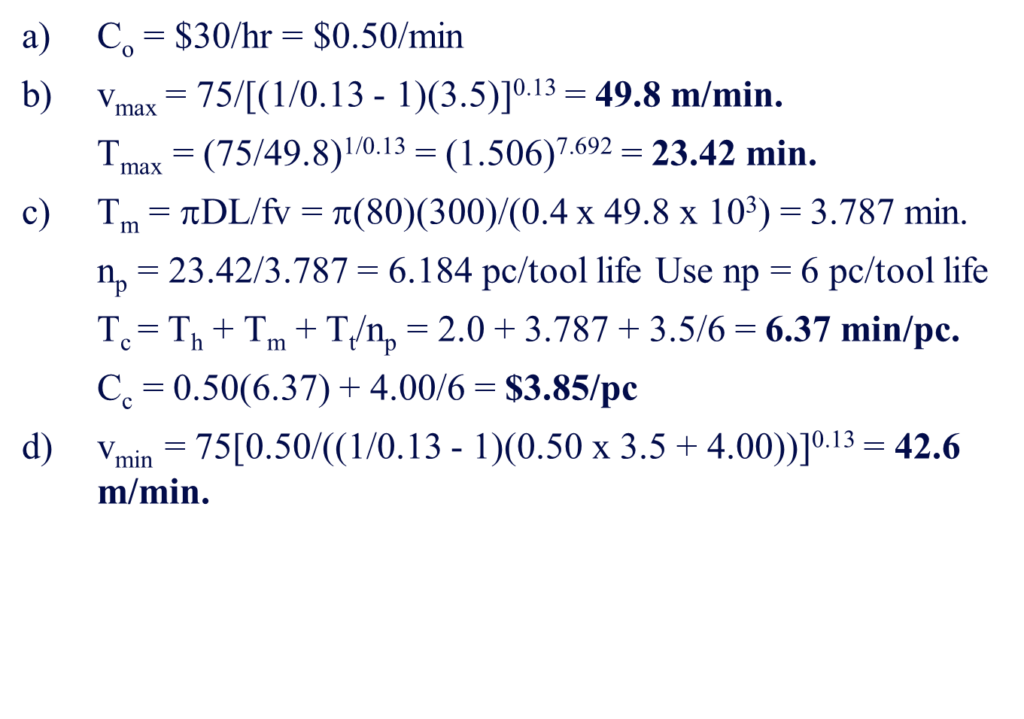Understanding Machining Economics
Machining economics encompasses a range of models and scenarios aimed at enhancing the effectiveness and efficiency of machining processes.
It involves optimizing the overall outcome of a machining process. At a micro-technological level, this means maximizing tool life, increasing the number of workpieces produced per cutting edge, adhering to pre-defined cycle times, minimizing tooling costs, maximizing tool performance, reducing tool manipulation times, and lowering machining costs.

Moving to a macroeconomic dimension, the focus shifts to achieving the highest possible productivity, minimizing process costs or maximizing profitability, ensuring process reliability and predictability, efficiently utilizing resources and energy, minimizing ecological impact, and achieving consistent workpiece quality. Machining economics might sound boring, but it’s important for the fabrication industry. In this article, we’ll go over machining economics, how to calculate machining costs and strategies for improving machining economics.
What is Machining Economics and Why is it Important?
Alright, so what the heck is machining economics? Simply put, it’s the study of optimizing the costs associated with metal cutting operations such as machining or grinding. The first step is to optimize the cost, defining the criteria that can be minimized or maximized as a function of variables that can be controlled in machining. This includes direct costs like materials, labor, and tooling, as well as indirect costs like overhead and maintenance. Businesses can make informed decisions about their operations by understanding these costs and how they affect profitability.

How to Calculate Machining Cost
So, how do you calculate the machining costs? It’s a bit more complicated than just adding up the cost of materials and labor. There are indirect costs to consider, like overhead and maintenance, that can add up quickly.
To calculate machining costs, you’ll need to consider both direct and indirect costs.
- Direct costs include things like materials, labor, and tooling.
- Indirect costs include things like overhead, depreciation, and maintenance.
Once you have a total for both direct and indirect costs, you can calculate the total machining cost per part (unit cost). This will give you a good idea of how much it costs to produce each part.

What remains constant in the economics of machining?
The cost of material is contingent upon the material type, size, and cost rate. It remains constant and is not influenced by cutting conditions.
How much does it cost to have a part machined (unit cost)?
Generally, the unit cost, or cost per piece (Cp), to fabricate a machined part ranges from $35 – $40 per hour for 3-axis machines and multi-axis machines cost $75 – $120 per hour.
The cost per piece (Cp) includes the cost of part machining per unit (Cm), set-up cost per unit (Cs), cost of handling per unit (loading/unloading) (Cl), and the cost of tooling per unit (Ct). The cost and be broken down and calculated using the following equation:

- Lm is the labor cost for production.
- Bm is the burden rate
- Di The depreciation of the insert in $ (cost of insert)
How to calculate machining production time:
The time to produce one part (Tp) can be calculated as:

- Tl is the part loading and unloading time
- Tm Time to machine one piece
- Tc Time required to change the insert
- Ti Time required to index the insert
- Ni Number of parts machined per insert
- Nf Number of parts that can be produced per insert face
Speed and Tool Life for Maximum Production Rate:

m is the number of insert faces that are used before it is discarded. D is the workpiece diameter
Speed and Tool Life for Minimum Unit Cost:

Where C is the tool life constant in the Taylor tool life equation, n is the tool life exponent, and m is the number of faces that are used
Strategies for Improving Machining Economics
Now that you know how to calculate machining costs, let’s talk about some strategies for improving machining economics. By reducing costs and improving efficiency, you can increase profitability and competitiveness in the industry.
Another way to improve machining economics is to reduce material waste and improve yield. This can be done by optimizing the cutting parameters and using the right tooling to avoid or minimize tool failure.
What are the 3 modes of tool failure?
Tool failure can occur due to:
- Fracture failure
- Temperature failure
- Gradual wear

What are the different mechanisms of tool wear?
The following interactions at the tool-workpiece and tool chip interface can lead to tool wear:
- Abrasion wear due to hard particles in the workpiece
- Adhesion wear due to high pressure and temperature
- Diffusion wear
- Chemical reaction (oxidation wear) of the rake face
- Plastic deformation of the cutting edge

What is meant by a tool life?
Another key enabler to improve your machining cost is optimizing tool life and machine utilization. This means keeping the machines running as much as possible and minimizing downtime.

Tool life is the length of cutting and the time that the tool can be used between sharpening. Typically an acceptable level of tool wear (cutting edge retains its cutting ability) is used as tool life instead of using the tool to failure. Tool wear starts rapidly during the “break-in period”, then a steady state (uniform) tool wear is observed, and finally, accelerated tool wear to failure.
What is the significance of Taylor’s tool life equation?
By optimizing tool life, you’ll be able to save money on tooling costs and improve efficiency. The Taylor equation is used to calculate cutter life in machining, making it one of the most important topics in mechanical engineering technology/ manufacturing processes.


How is tool life influenced by the workpiece material?
The mechanical properties of the workpiece material such as tensile strength and hardness do affect the tool life of the cutter. As the hardness of the material increase the cutting speed needs to decrease to reduce the impact on tool life, the biggest reason for this is to enable the tool to manage the temperature and quality of the cut.

Why the speed has more impact on tool life?
The graph below shows the Tool-life curves for a variety of cutting-tool materials. Tool life decreases as the cutting speed increases, which can be seen from the negative reciprocal of the slope of these curves. The degree of wear is determined by the cutting speed because too high of a speed can cause flank wear or crater wear.

Improving Machining Economics
Another way to improve machining economics is through process optimization. This means identifying bottlenecks and inefficiencies in the machining process and finding ways to improve them. As a rule, the feed of a workpiece should be maximized first and speed second, however, this depends on the:
- Tool material
- Type of cut (roughing or finishing)
- Constraints on feed
- Cutting forces, setup rigidity, horsepower
- Surface finish requirement
Cutting speed can be optimized to:
- maximize production rate
- minimize unit cost
as a result, to optimize production, you want to be in the high-efficiency machining range. Note that there is an optimum cutting speed for both cost and time, respectively. The range between the two optimum speeds is known as the high-efficiency machining range.
Optimize machining cost through Process Optimization
Another way to optimize the machining process is to implement Lean manufacturing (just-in-time manufacturing) principles. This involves identifying and eliminating waste in the production process. By reducing waste, you can improve efficiency and reduce costs.
You can also use data analysis to identify areas for improvement. By collecting and analyzing data on the machining process, you can identify bottlenecks and inefficiencies and find ways to improve them.
Finally, continual process improvement and optimization is essential for improving machining economics. By continually assessing and improving the machining process, you can ensure that your business is running at peak efficiency and profitability.
The Bottom Line
understanding machining economics is crucial for success in the manufacturing industry. By understanding and optimizing costs, businesses can improve profitability and competitiveness. This involves considering all factors that affect machining economics, including direct and indirect costs, as well as external factors such as market demand and competition. Strategies for improving machining economics include identifying and reducing inefficiencies, maximizing equipment utilization, implementing cost-saving measures, and adopting new technologies. Continual assessment and improvement of machining economics is essential for long-term success in the industry.

Sample Problem:
An HSS tool is used to turn a steel workpiece that is 300 mm long and 80 mm in diameter. The parameters in the Taylor equation are n = 0.13 and C = 100 (m/min) for a feed of 0.4 mm/rev. The labor rate = $19.00/hr, the burden rate is $15.00/hr, and each square ceramic insert cost $25.00. It takes 2.0 min to load and unload the workpiece and 5.0 min to change tools and 1.0 minutes to index. Determine:
- cutting speed for maximum production rate,
- tool life in min of cutting,
- cycle time and cost per unit of product
- cutting speed for minimum unit cost.

Conclusion
In conclusion, understanding machining economics is paramount for optimizing the efficiency and effectiveness of machining processes. By delving into the intricate balance of micro-technological and macro-economic considerations, manufacturers can strive for enhanced productivity, reduced costs, and improved overall quality. With a keen awareness of material costs, tool performance, and process reliability, businesses can navigate the complexities of machining economics to achieve sustainable and competitive manufacturing operations.




